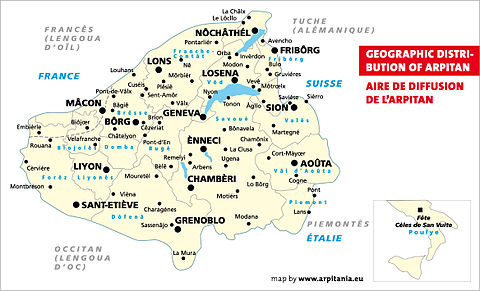Arpitania



Arpitania (Arpitan and Italian: Arpitania, French: Arpitanie) consists of the lands where the Arpitan language is spoken or used to be the prevalent idiom.[1] Arpes in Arpitan means Alps, thus the territory name would be translated as "Land of the Alps".
Arpitania and Arpitan Language are retronyms. They were neologisms from the 20th century. It was initially used for the Alpine regions where Arpitan was spoken. The name was popularised by Mouvement Harpitanya, a left-wing political grouping in Aosta Valley lead by Joseph Henriet in the 1970s.[2] In the 1990s, the term lost its particular political context.[3] However, the use of the word "Arpitania" indicates a common cultural heritage and a regional identity beyond linguistic limitations.[4]
Inhabitants of the region, whether they are actual speakers of the language or not, are called Arpitans.[5][6]
Geography

Arpitania includes parts of:
- France (Ain, Rhône, Savoie, Haute-Savoie, a big part of the Isère department, southern Franche-Comté).
- Italy (Aosta Valley, Arpitan-speaking valleys in the Piemont, Daunia/Arpitan Celle di San Vito, Foggia in Apulia).
- Switzerland (Romandy, excluding the northern and western parts of Jura).
The northwestern salient (roughly a strip between Mâcon and Roanne) is seen linguistically transitional between Arpitan, Occitan, and other Oïl languages.
Books
- Jozé Harrieta, La lingua arpitana, 1976.
- Mikael Bodlore-Penlaez, «Savoy and Aosta, heart of the Arpitan people» in Atlas of Stateless Nations in Europe: Minority People in Search of Recognition, Y Lolfa, 2011. ISBN 978-1-84771-379-7
References
- ^ "did you say arpitan?" on Arpitania.eu Archived July 20, 2011, at the Wayback Machine.
- ^ * Gianpaolo Charrere, Ayas, un film sul sogno dell'Harpitanya, Aoste: La Stampa, 15 february 2012 and "La nation arpitane"
- ^ Nos ancêtres les Arpitans Archived 2011-07-15 at the Wayback Machine, 24 Heures, Lausanne, 2 May 2009
- ^ Aliance Cultutèla Arpitana, Fribourg (Switzerland) and Rochetaillée (France), http://aca.arpitania.eu.
- ^ Les Alpes et leurs noms de lieux, 6000 ans d'histoire ? : Les appellations d'origine pré-indo-européenne., Paul-Louis Rousset, 1988, ISBN 2-901193-02-1
- ^ Les mots de la montagne autour du Mont-Blanc, Hubert Bessat et Claudette Germi, Ed. Ellug, Programme Rhône-Alpes, Recherches en Sciences Humaines, 1991, ISBN 2-902709-68-4.
External links
- Portal Arpitania.eu
- Babel Lexilogos (French)
- Harpitanya Movement Flag
- Listen to some audio documents in an Arpitan dialect.
